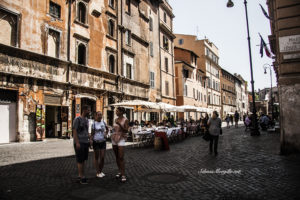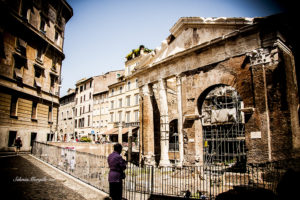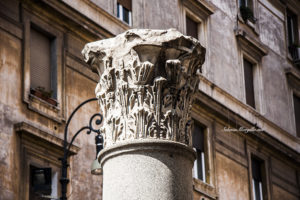The Jewish Ghetto in Rome
Italian Version Below*
The presence of the Jewish community in Rome has ancient roots. The Jews had been present in the city since the second century BC. Their number grew in the first century AD after the conquest of Jerusalem by Vespasian and Titus.
With the Protestant reform, the popes’ attitude tightened. Pope Paul IV, in 1555, ordered the construction of the ghetto of Rome, among the oldest in Europe, in an area little more than three hectares and issued the bubble cum nimis absurdum (“because it is extremely inconceivable”).
All the rights granted to the Roman Jews were revoked and initially, only two gates were closed to close and open the entire area.
The community had to comply with numerous obligations: to reside within the ghetto, to return before sunset, to always have a community badge with it, not to own real estate, and to exercise only and exclusively trade in rags and clothes.
The area chosen to build the ghetto falls in the current Rione Sant’Angelo, the smallest of the 22 within the city of Rome. The area included streets that have now disappeared, between Piazza Giudea, Via del Portico d’Ottavia, and the bank of the Tiber near the Tiber Island.
In the mid-seventeenth century, the inhabitants of the ghetto were around 9000 and the space in which they lived was decidedly cramped and unhealthy also due to the continuous flooding of the Tiber. Segregation was abolished only in 1849 and in 1870 the rights of Jews equated with Italian citizens.
The last sad page dates back to October 16, 1943, the famous “Black Saturday”, when over 1000 Jews were deported to the Auschwitz concentration camp with 18 cattle wagons from Tiburtina Station. Only 16 returned to Rome.
The memory of this event is remembered in Largo 16 October 1943 overlooking the Portico d’Ottavia and the “Stumbling blocks” (Stolpersteine), contemporary art installations by the German artist Gunter Demnig placed on the road near the homes of the deportees.
To visit: Jewish Museum
Info Site: it is advisable to start the visit from the archaeological area of the Teatro di Marcello
Art & Food: Antico Forno Boccione Urbani Sora Margherita
Support #culturachevince, help sharing.
All rights reserved*
La presenza della comunità ebraica a Roma ha radici antiche. Gli ebrei erano presenti in città dal II secolo a.C. Il loro numero crebbe nel I secolo d.C. dopo la conquista di Gerusalemme da parte di Vespasiano e Tito.
Con la riforma protestante, l’atteggiamento dei pontefici si inasprì. Papa Paolo IV, nel 1555, ordinò la costruzione del ghetto di Roma, tra i più antichi d’Europa, in un’area grande poco più di tre ettari ed emanò la bolla cum nimis absurdum (“poiché o oltremodo inconcepibile”).
Furono revocati tutti i diritti concessi agli ebrei romani e disposti inizialmente due soli varchi a chiusura ed apertura dell’intera zona.
La comunità doveva rispettare numerosi obblighi: risiedere all’interno del ghetto, rientrare prima del tramonto, avere sempre con sé un distintivo della comunità, non possedere beni immobili ed esercitare solo ed esclusivamente commercio di stracci e vestiti.
La zona prescelta per edificare il ghetto cade nell’attuale Rione Sant’Angelo, il più piccolo dei 22 all’interno della città di Roma. L’area comprendeva vie oggi scomparse, fra Piazza Giudea, Via del Portico d’Ottavia e la riva del Tevere presso l’Isola Tiberina.
Nella metà del XVII secolo, gli abitanti del ghetto erano circa 9000 e lo spazio in cui vivevano era decisamente angusto ed insalubre anche a causa delle continue inondazioni del Tevere. La segregazione fu abolita solo nel 1849 e nel 1870 i diritti degli Ebrei equiparati ai cittadini italiani.
L’ultima triste pagina risale al 16 ottobre 1943, il celebre “sabato nero”, quando oltre 1000 ebrei furano deportati verso il campo di concentramento di Auschwitz con 18 carri bestiame dalla Stazione Tiburtina. Solo in 16 fecero ritorno a Roma.
La memoria di questo evento è ricordata in Largo 16 ottobre 1943 prospicente il Portico d’Ottavia e dalle “Pietre d’inciampo”, installazioni d’arte contemporanea dell’artista tedesco Gunter Demnig poste sul soglio stradale nei pressi delle abitazioni dei deportati.
Sostieni la #culturachevince, aiuta la condivisione.
Da visitare: Museo Ebraico
Info Site: è consigliabile iniziare la visita dall’area archeologica del Teatro di Marcello
Art & Food: Antico Forno Boccione Forno Urbani Sora Margherita


